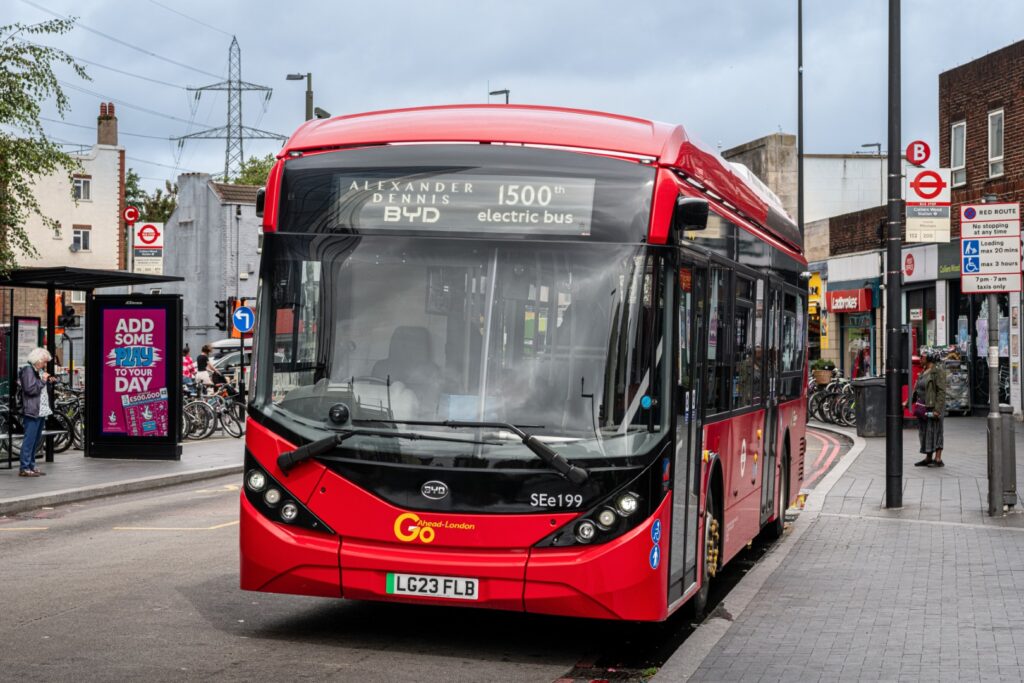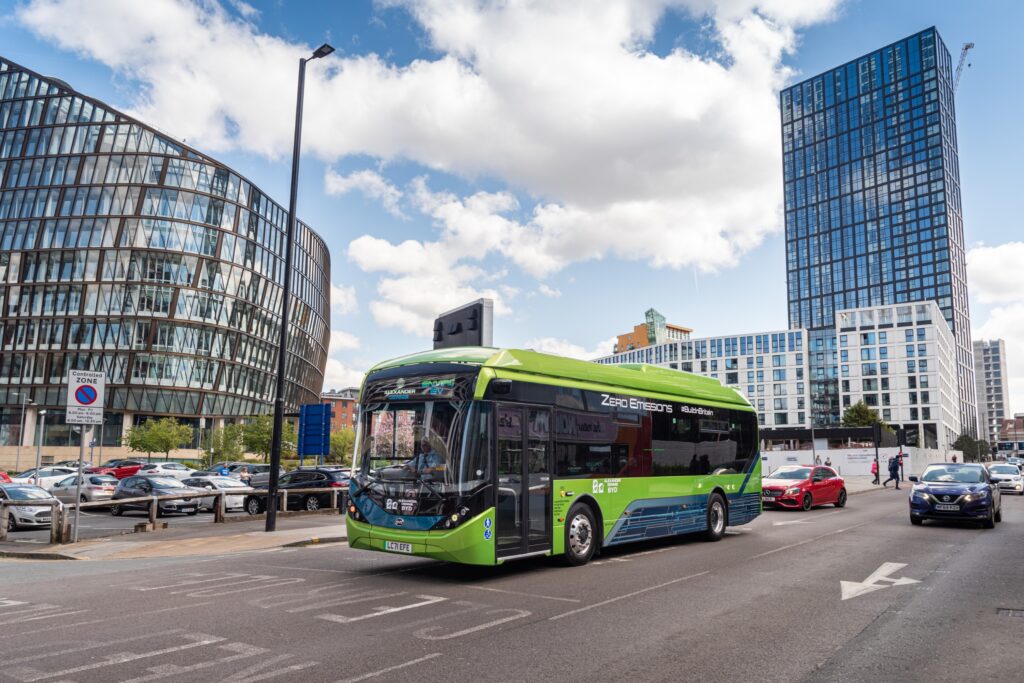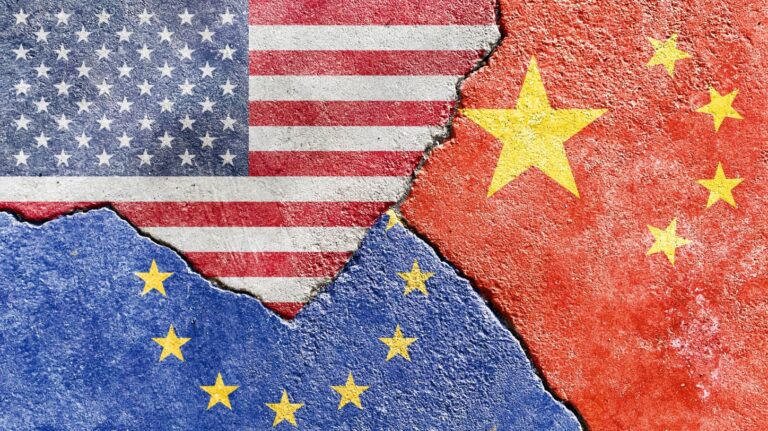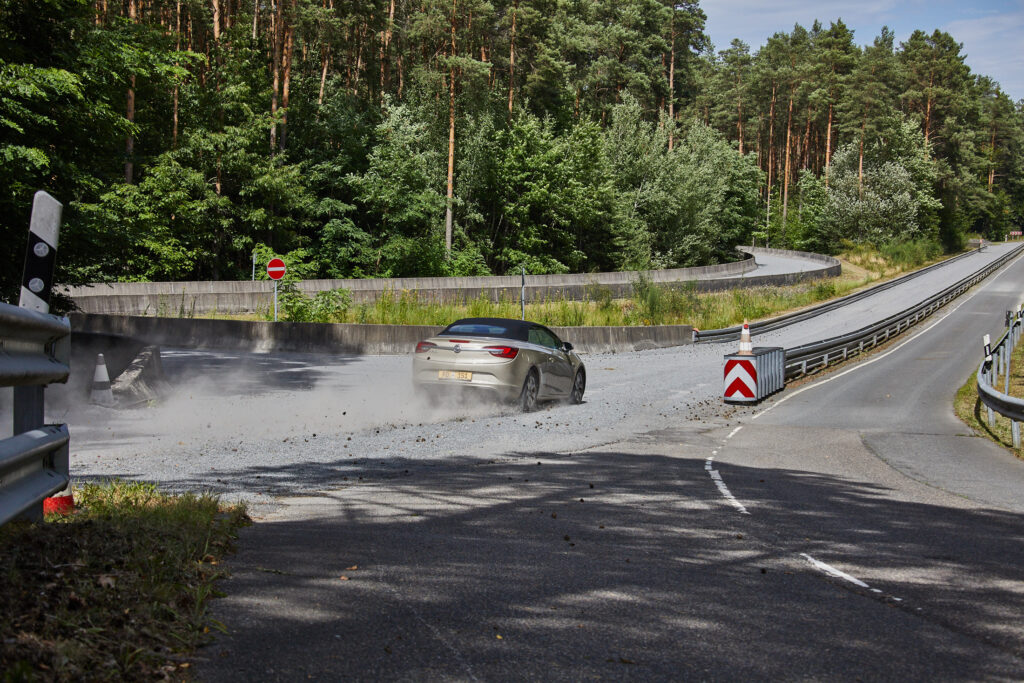As the European Union and USA escalate sanctions on Chinese EV imports, what are the implications for Europe’s green ambitions and its automotive industry?
In 2018, the then US president Donald Trump, concerned with what his administration perceived as unequal bilateral trade, imposed the first of a series of tariffs against the People’s Republic of China (PRC). Levied against solar panels and washing machine imports (at 30% and 20% for the first year respectively), both were designed to negate trade dumping – when a manufacturer intentionally exports at prices lower than the cost of production – and increase domestic competitiveness.
In 2019, when the Trump administration imposed a 10% tariff on US$300bn (£224bn) of PRC goods, Beijing’s retaliatory tariffs targeted thousands of individual products in addition to a net ban on US agricultural exports worth US$110bn (£82bn). It was amid these streams of red tape that the USA prioritised its primary concern: China’s dumping of electric vehicles (EV) – a concern shared by US ally the European Union (EU).
Historically, the EU has maintained a cordial trade relationship with China since modern relations began in 1975. Each is the other’s largest foreign trading partner and in 2023 Chinese goods equated to 20.5% and 8.8% of all goods imported and exported respectively into the EU, according to the European Commision. In March 2019, however, the EU changed its tact, terming the PRC ‘an economic competitor in the pursuit of technological leadership, and a systemic rival’. Imports of Chinese EVs, which, according to US White House, increased by 70% between 2022/23 – rising from €904m (£786m) to €3.4bn (£2.96bn) concurrently in the EU – proved the final straw.
“Europe needs a strong industrial policy to speed up electrification and localise manufacturing.” – Julia Poliscanova, senior director for vehicles and e-mobility supply chains, T&E
On 03 October 2023, an EU initiation notice officially launched an anti-subsidy proceeding against PRC imports. Concerned with the ‘existence of subsidisation by the PRC that negatively affects the situation of the Union industry’, on 11 June 2024 a provisional reading was released that imposed tariffs ranging from 17-38.4% on incoming EVs. Concurrently, US EV tariffs passed 102.5% on incoming Chinese EVs, with 50% on solar cells and 25% on EV battery parts.
As geostrategic influences exert themselves in escalating EV sanctions, automotive manufacturers and governments are feeling the supply-chain squeeze. So, the question becomes, how is the globalised, deeply interwoven EU vehicle manufacturing industry coping with the sanctions and how does this affect national decarbonisation efforts in countries across the European continent?
Rise of the e-dragon
To help answer that question, we need to look back. In the early 2000s, the PRC stood at a crossroads. After the ‘Seventh Five-Year Plan’ prioritised car manufacturing in 1986, China attempted to harness the same ideals that had spurred its economic miracle the ‘rise of the dragon’. By the turn of the century, however, its behemoth of collectivised industry was still tailored to mass-production; ill-equipped to cater to the high-quality, bespoke demands of more discerning international consumers.
Cheap, quick to produce western-imitation vehicles had earned Chinese manufacturers a reputation for unreliable quality and safety. The stranglehold legacy car brands in the EU and USA held over China’s consumer consciousness (with almost a century head start) compounded the disparity. Japan, the world’s other major car manufacturer, had also already made significant advancements in hybrid technology, negating Chinese forays into that market. The PRC could either attempt to force its way into the extremely competitive internal combustion engine market or utilise its highly efficient industrial complex to invest in the relatively small but emerging EV market. PRC policymakers chose the latter.
FAST FACT: The US trade deficit with China in 2023 was approximately US$280bn. Source: US Census Bureau
Creating a self-actuating industry (in China’s case, one free of state intervention) required three factors; high-quality, cheap pricing and ubiquity. In 2001, China sought to fabricate these conditions by entering the World Trade Organization (WTO) and implementing the ‘863 EV Project’ – a transformative initiative part of the broader ‘863 Program’ (also known as the ‘State High-Tech Development Plan’), which was a government initiative launched in 1986 to enhance the country’s technological capabilities and reduce reliance on foreign innovations.
Firstly, entering the WTO necessitated that China bring its economic policies in line with existing members. According to the United Nations Conference on Trade and Development, imports into China increased by 117% in 2002 alone, which, although a short-term barrier to domestic brand consumption, fostered a lasting car culture among China’s burgeoning middle class.
As demand subsequently grew over the years, and western brands such as Tesla eventually relocated their manufacturing plants to the source of this emerging market, China activated its economic lever: joint venture enterprises. By mandating that any foreign manufacturer must establish a joint enterprise with a Chinese counterpart (with the latter owning a minimum of half of the business), capital, jobs and trained personnel were retained.
Secondly, wherein WTO membership initially opened the barriers to car ownership, the ‘863 EV Project’ ensured that a flood of new consumers saturated China’s domestic market. This then led to the formation of the China Electric Vehicle Association, based in Beijing and formed by 16 companies with the implicit aim of integrating improved technological standards into Chinese manufacturing.

By 2009, the nation saw an average of 21% manufacturing growth per year (between 2002 and 2007), becoming the largest producer in the world. Max Reid, principal analyst of EVs and battery supply chain services data analytics at research and consulting firm Woods Mackenzie, explains how China was able to successfully corner the market: “Chinese-made EV batteries not only come at a discount but are also available in much higher quantities because the manufacturing capacity has been built out in China and continues to be built out.”
The final nail in the electric chassis – so to speak – was the establishment of the PRC’s ‘dual credits’ system, granting local manufacturers 200bn RMB (£22bn) in funds, subsidies and tax breaks between 2009 and 2022. Automotive OEMs BYD, GAC Aion and SAIC- GM-Wuling – and brands that now produce 60% of global EVs according to Adamas Intelligence – rose to prominence through this system. With dominance secured, the next step was to go global.
Home going
In a June 2024 statement, Transport and Environment (T&E), a European umbrella for non-governmental organisations promoting sustainable transport, claimed that “one in four EVs sold in Europe this year could be imported from China”. Julia Poliscanova, senior director for vehicles and e-mobility supply chains at T&E, added: “Europe needs a strong industrial policy to speed up electrification and localise manufacturing.”
For comparison, in 2024, the EU collectively produced 25% of the world’s EV supply across its 27 member states. The prevalence of Chinese EVs in Europe is thus a double-edged sword. On one hand, the EU and adjacent European countries have identified transport as their major contribution to climate change. In accordance with the EU’s 2030 ambition for 30% of all new vehicle sales to be electric, effectively decarbonising public and private transport is now intrinsic to its climate, fiscal and industrial policy.
On the other hand, where China made great strides toward EV production, the EU did not and could not replicate the same scale of industrial output. Thus, the EU now must contend with increasing its EV supply without comprising its own industrial capacity. Its answer is tariffs. Conversely, the very supply chains and manufacturing companies the tariffs are designed to protect have not won over their intended beneficiaries.
Reacting to the sanctions, German carmaker Volkswagen said: “The negative effects of this decision outweigh any potential benefits for the European and especially the German automotive industry. Europe needs a regulatory environment in which the automotive industry is strengthened in the transformation to e-mobility and climate neutrality.”

The tariffs also coincided with the EU considering reneging on its 2035 zero-emission car target, the onus seemingly on impeding Chinese brands rather than reducing carbon emissions. Reacting to the report, T&E stated: “Just introducing tariffs while scrapping the 2035 deadline for polluting cars would slow down the transition and be self-defeating.”
Interestingly, the tariffs imposed by the EU and USA have resulted in Chinese brands manufacturing their products in those territories to bypass the import tariffs. For example, BYD, which received a 17% sanction in the most recent EU amendment, stated that it would increase its production within the EU. Speaking to Reuters, BYD executive vice president Stella Li said: “[We will] buy the maximum [allowance] from European vendors… politicians should stay away from tariffs, adding more cost to auto manufacturing and confusing the auto industry.”
To this end, BYD has also announced plans to open a plant in Mexico. The facility, which has a projected sales goals of 100,000 vehicles by 2025, aims to bypass US tariffs in the same vein by utilising local manufacturers. Sören Mueller, COO for software and digitalisation of Segula Technologies, a R&D, technology and automotive testing company, corroborates this business strategy, with its own forecasts for foreign business partnerships increasing in the tariff’s wake.
“I’m speaking market-wise in Europe,” says Mueller. “But the origin of the cars or the origin of the companies is China, and a few other Asian countries such as South Korea has increased.”
Similar strategies have been employed in EU adjacent countries, forgoing tariffs for greater cooperation to interweave PRC production capacity into national decarbonisation efforts. For example, the UK, which officially left the EU on 31 January 2020, has embraced PRC-built EVs as the country chases its own Net Zero 2040 target through the zero-emission vehicle mandate. As of 2023, there were more than 1,500 electric buses in the UK of Chinese origin with 600 in London alone.
UK-based bus manufacturer Alexander Dennis Limited has partnered with BYD to fulfil the capacity demanded of local authorities. In 2021, the two companies jointly produced some 194 electric buses for London-based bus operator RATP Dev London.
Frank Thorpe, managing director of BYD UK, said at the time: “Public transport in the capital often provides the blueprint for other towns and cities and the fact that a major operator like RATP Dev is making such a substantial commitment to e-mobility will, I believe, resonate with local authorities across the UK.”
FAST FACT: China was the EU’s largest source of imports in 2023, accounting for 20.5% of its total. Source: European Commission
Similarly to the PRC model, the UK seeks foreign collaboration in order to increase competitiveness, believing that it will pay the same dividends it did to the PRC’s EV industry. This echoes the concerns of EU-based manufacturers and suppliers as Volkswagen, Segula Technolgies and Renault have all sought closer ties with Chinese brands. The UK government has also targeted an expansion of EV charging infrastructure, setting the goal of 300,000 public EV charging points across the country by 2030 – the new Labour administration upholding this Conservative policy.
Thus, the influx of Chinese-made EVs – both private and public –supplements the UK’s domestic EV charging infrastructure industry. While the UK decarbonises, the incoming of Chinese capital and technological innovation can create the conditions to support a much larger EV market as the domestic industry acclimatises to demand.
Emperor’s new cars
At the time of writing, Donald Trump has just secured his second term as US president and he has promised to raise sanctions on Chinese manufacturing. Apart from Ford’s proposed US$3.5bn (£2.7bn) EV battery plant in Michigan, there are currently no plans for any EV plants to be built in the USA and the 100% tariff Trump has touted may prevent further investment. What’s more, the incumbent president has vowed to impose a 200% tariff on EVs made by Chinese companies in Mexico, which is bad news for BYD. In Europe, Trump’s re-election has exacerbated the tariff situation as he has suggested imposing a flat 10-20% tax on all imports, focusing on car manufacturers and Germany specifically.
With the EU showing no sign of abandoning its 2050 climate promises pledged at the 2015 Paris Climate Agreement, a closer partnership with China may be the way forward for decarbonisation. German chancellor Olaf Scholz, long outspoken against tariffs, spoke out against the EU’s policy at the Berlin Global Dialogue event in October 2024. “Negotiations with China on EVs must continue,” he implored. “We as the EU must not harm ourselves in trade conflicts.”
A combination of planned gigafactories, EV charging infrastructure expansion and US sanctions will likely necessitate greater levels of expertise and capital. As for countries that flout the sanctions all together, this could present an unrivalled opportunity. Commenting on the lack of UK tariffs, UK trade minister Jonathan Reynolds said: “We keep it under close analysis, but I think it’s important our industry is different.” With the severity of the proposed sanctions uncertain, what is clear is that Trump, tariffs and the tearing down of the established EV order will remain high on the EU’s decarbonisation agenda throughout the 47th US president’s tenure.
Testing Times
As the EU-China trade war becomes entangled in bureaucracy, industries involved in EV manufacturing and supply chains are grappling with geopolitical trends that are constraining their operations. Specialising in automotive R&D, product development and project management, Segula Technologies, headquartered in Nanterre, France, has carved out a niche in the European market, tailoring its design, development and testing services to major car manufacturers.Through its Rüsselsheim, Germany-based subsidiary, Segula Technologies GmbH, the company provides homologation services to help automotive brands comply with local regulations in Europe and the UK. Sören Mueller, COO for software and digitalisation at Segula, explains how the industry is addressing EV tariffs and their impact on decarbonisation.
“We are seeing more homologation requests because Chinese companies already have cost-effective engineering capabilities in China but need a local presence to adapt products for regional markets,” says Mueller. “Being homologation-ready and meeting market expectations in Europe is where we see growing demand.”
To navigate tariffs, Chinese brands are increasingly partnering with European firms to develop services for domestic markets. Meanwhile, traditional EU, British and US brands have reduced costs by closing testing facilities, creating further opportunities for testing and development outfits such as Segula. “Many automotive OEMs have shut their test centres and are now outsourcing services they previously conducted in-house,” Mueller says.
Europe’s push to decarbonise transport and encourage EV uptake has driven private-sector EV development, resulting in increased testing at Segula’s Rüsselsheim facility. “We’ve initiated projects in EV, hybrid and fuel-cell applications,” says Xavier Chapuy, international CEO at Segula Technologies. “While investing in these technologies, we’ve also retained a focus on internal combustion engines, as the transition to EVs won’t happen overnight.”
Adapting vehicles for different markets requires rigorous testing to meet the strictest regulations. “You need regional adaptations,” Mueller says. “This includes homologation and market-specific expertise, particularly in Europe, where regulations and customer expectations are complex.”
For example, Chinese car manufacturers entering Europe must comply with the EU’s strict battery manufacturing standards and anticipate future legislative changes that could quickly render the vehicle non-compliant. “We anticipate new regulations,” Chapuy adds. “Waiting for regulation is too late. We collaborate with organisations and governmental bodies to stay ahead and make forward-looking investments.”
Segula also supports the adaptation of public transportation systems. Chinese manufacturer BYD, for instance, has produced more than 70,000 electric buses – representing 40-50% of the global stock. Future collaborations with Chinese vehicle manufacturers may extend into rail, buses and shuttles.
This article was originally published in the December 2024 issue of CiTTi Magazine.
Subscribe for free to the quarterly print edition of CiTTi Magazine for exclusive insights into the key business issues shaping the future of sustainable urban mobility. Stay ahead of the curve by signing up for the free CiTTi weekly newsletter, delivering sector-leading content straight to your inbox every Friday. For even more updates, follow CiTTi Magazine on X (formerly Twitter) and LinkedIn. LinkedIn followers can also subscribe to Urban Digest — a weekly newsletter curated exclusively for the CiTTi Magazine LinkedIn community.






